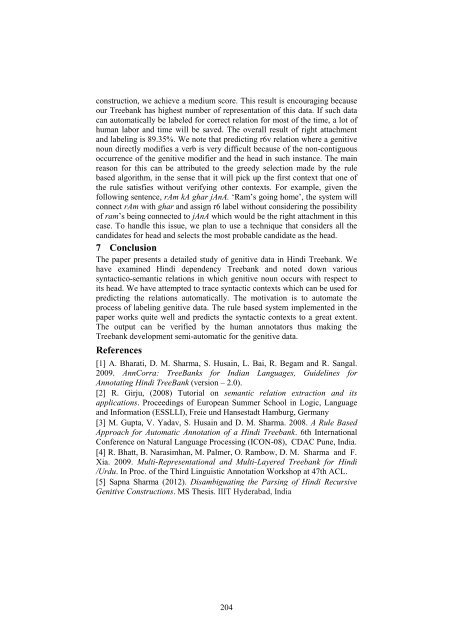A Treebank-based Investigation of IPP-triggering Verbs in Dutch
A Treebank-based Investigation of IPP-triggering Verbs in Dutch
A Treebank-based Investigation of IPP-triggering Verbs in Dutch
Create successful ePaper yourself
Turn your PDF publications into a flip-book with our unique Google optimized e-Paper software.
construction, we achieve a medium score. This result is encourag<strong>in</strong>g because<br />
our <strong>Treebank</strong> has highest number <strong>of</strong> representation <strong>of</strong> this data. If such data<br />
can automatically be labeled for correct relation for most <strong>of</strong> the time, a lot <strong>of</strong><br />
human labor and time will be saved. The overall result <strong>of</strong> right attachment<br />
and label<strong>in</strong>g is 89.35%. We note that predict<strong>in</strong>g r6v relation where a genitive<br />
noun directly modifies a verb is very difficult because <strong>of</strong> the non-contiguous<br />
occurrence <strong>of</strong> the genitive modifier and the head <strong>in</strong> such <strong>in</strong>stance. The ma<strong>in</strong><br />
reason for this can be attributed to the greedy selection made by the rule<br />
<strong>based</strong> algorithm, <strong>in</strong> the sense that it will pick up the first context that one <strong>of</strong><br />
the rule satisfies without verify<strong>in</strong>g other contexts. For example, given the<br />
follow<strong>in</strong>g sentence, rAm kA ghar jAnA. „Ram‟s go<strong>in</strong>g home‟, the system will<br />
connect rAm with ghar and assign r6 label without consider<strong>in</strong>g the possibility<br />
<strong>of</strong> ram‟s be<strong>in</strong>g connected to jAnA which would be the right attachment <strong>in</strong> this<br />
case. To handle this issue, we plan to use a technique that considers all the<br />
candidates for head and selects the most probable candidate as the head.<br />
7 Conclusion<br />
The paper presents a detailed study <strong>of</strong> genitive data <strong>in</strong> H<strong>in</strong>di <strong>Treebank</strong>. We<br />
have exam<strong>in</strong>ed H<strong>in</strong>di dependency <strong>Treebank</strong> and noted down various<br />
syntactico-semantic relations <strong>in</strong> which genitive noun occurs with respect to<br />
its head. We have attempted to trace syntactic contexts which can be used for<br />
predict<strong>in</strong>g the relations automatically. The motivation is to automate the<br />
process <strong>of</strong> label<strong>in</strong>g genitive data. The rule <strong>based</strong> system implemented <strong>in</strong> the<br />
paper works quite well and predicts the syntactic contexts to a great extent.<br />
The output can be verified by the human annotators thus mak<strong>in</strong>g the<br />
<strong>Treebank</strong> development semi-automatic for the genitive data.<br />
References<br />
[1] A. Bharati, D. M. Sharma, S. Husa<strong>in</strong>, L. Bai, R. Begam and R. Sangal.<br />
2009. AnnCorra: TreeBanks for Indian Languages, Guidel<strong>in</strong>es for<br />
Annotat<strong>in</strong>g H<strong>in</strong>di TreeBank (version – 2.0).<br />
[2] R. Girju, (2008) Tutorial on semantic relation extraction and its<br />
applications. Proceed<strong>in</strong>gs <strong>of</strong> European Summer School <strong>in</strong> Logic, Language<br />
and Information (ESSLLI), Freie und Hansestadt Hamburg, Germany<br />
[3] M. Gupta, V. Yadav, S. Husa<strong>in</strong> and D. M. Sharma. 2008. A Rule Based<br />
Approach for Automatic Annotation <strong>of</strong> a H<strong>in</strong>di <strong>Treebank</strong>. 6th International<br />
Conference on Natural Language Process<strong>in</strong>g (ICON-08), CDAC Pune, India.<br />
[4] R. Bhatt, B. Narasimhan, M. Palmer, O. Rambow, D. M. Sharma and F.<br />
Xia. 2009. Multi-Representational and Multi-Layered <strong>Treebank</strong> for H<strong>in</strong>di<br />
/Urdu. In Proc. <strong>of</strong> the Third L<strong>in</strong>guistic Annotation Workshop at 47th ACL.<br />
[5] Sapna Sharma (2012). Disambiguat<strong>in</strong>g the Pars<strong>in</strong>g <strong>of</strong> H<strong>in</strong>di Recursive<br />
Genitive Constructions. MS Thesis. IIIT Hyderabad, India<br />
204
















